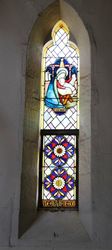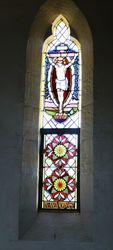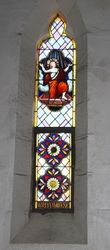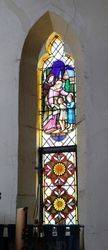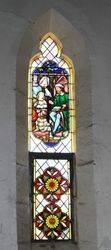
William KeenePrint Page 
The stained glass windows, erected by subscription, commemorate William Keene (1798 - 1872), who was a geologist.
In 1852 Keene and family arrived in Sydney and in 1853 he made an appraisal of the geology around the Fitzroy iron-mines near Mittagong for the government. On 28 December 1854 he was appointed examiner of coalfields. From 1863 he was stationed in the Hunter valley with the additional duties of keeper of mining records. His geological work in Australia was mainly on the coal-bearing rocks of the Sydney basin in the Hunter River valley.
In 1858 Keene opened a display of minerals and rocks that became a focal point for scientists visiting the district. He supplied geological collections for a number of institutions overseas and prepared displays of the colony's mineral wealth for exhibitions in London in 1862, Melbourne in 1866 and Paris in 1867, and won several medals.
Keene was a member of the Hunter River Vineyard Association and its president in 1865-66; his presidential addresses were published in 1867. He judged wine entries at many shows and constantly argued that the southern French treatment for wines was more suited to the New South Wales climate than the German. He also helped to form an association for widows and orphans of clergymen, and for some years was a magistrate. On 2 February 1872 he died aged 74 at his home in Raymond Terrace and was buried in the Anglican cemetery.
MEMORIAL STAINED GLASS WINDOW IN ST JOHN'S CHURCH, RAYMOND TERRACE, TO THE LATE WILLIAM KEENE ESQ -
This window was placed in St John s Church, Raymond Terrace, last week and as it is the admiration of all who have viewed it, a short description may be in interesting to your readers, whilst it is due to those kind friends who contributed towards the window. It may be as well to state in the first place, that the Church of St John is a Gothic edifice, pleasantly situated on a spot which affords a view of the Hunter River and of the rich alluvial farms spreading for miles on the opposite side, the churchyard is neatly kept having been tastefully laid out and planted with choice evergreen trees about six years ago.
The east window of the church consists of three lancet lights, the central light is eleven foot high, being admirably adapted for the style and subjects which have been chosen. Commencing at the foot of the light, there is the scene of our Saviour's birth. In the centre of the light is represented the Crucifixion and this is again surmounted by the Resurrection. These subjects are all taken from the old masters, and are beautifully executed. The intermediate spaces are occupied with chaste and varied medallions, and the sacred monograms I.H.S. In the right side light there is an admirably designed and well finished group representing a venerable teacher engaged in instructing those around him, the countenances of this group are peculiarly pleasing. In the left side light is likewise a corresponding group, consisting of a benevolent person, and a female figure of benign aspect, engaged in receivlng orphan children. It is scarcely necessary to say that these subjects are intended to perpetuate the memory of the offices which the deceased gentleman so long and faithfully filled in the Church of the Diocese as member of the Local School Board, and Founder and Treasurer of the Clergy Widows' and Orphans' Fund.
The inscription under these subjects respectively is, 'Teach the Ignorant,' 'Help the Helpless.' The window adds much to the beauty of the chancel and the church generally. It cannot fail to give great pleasure to H. B. Cotton, Esq, of Newcastle, who has taken a large amount of trouble and interest in accomplishing the work, and the friends of the deceased must be greatly gratified and comforted when they gaze upon this tribute of respect and affection to their departed relative. It is due to the firm of Messrs, Fergusson, Urie, and Lyon, of Melbourne, to say that the window is regarded as a beautiful specimen of Australian art, which will favourably compare with works of a similar character executed in England. The cost of the window, with transmission and erection, has been £80. The inscription at the base of the memorial is, "To the Glory of God, and in memory of William Keene, 1872"- Newcastle Pilot, Nov.30.
The Maitland Mercury and Hunter River General Advertiser (NSW ),
3 December 1872.
Location
| Address: | 45 Sturgeon Street, St John`s Anglican Church, Raymond Terrace, 2324 |
|---|---|
| State: | NSW |
| Area: | AUS |
| GPS Coordinates: | Lat: -32.764854 Long: 151.741828 Note: GPS Coordinates are approximate. |
Details
| Monument Type: | Window |
|---|---|
| Monument Theme: | People |
| Sub-Theme: | Science |
| Designer: | Fergusson, Urie & Lyon (Melbourne, VIC) |
| Monument Manufacturer: | Fergusson, Urie & Lyon (Melbourne, VIC) |
| Link: | http://adbonline.anu.edu.au/adbonli… |
Dedication
| Approx. Monument Dedication Date: | November-1872 |
|---|
The glory of God
In memory of William Keene
1872


